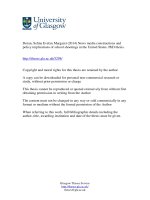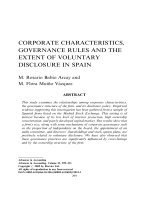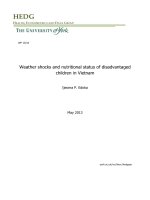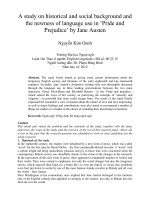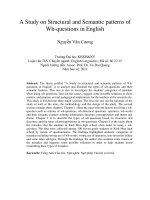Characterization and UV disinfection of tropical bacteria in ambient air
Bạn đang xem bản rút gọn của tài liệu. Xem và tải ngay bản đầy đủ của tài liệu tại đây (3.21 MB, 162 trang )
CHARACTERIZATION AND UV DISINFECTION
OF TROPICAL BACTERIA IN AMBIENT AIR
XU MIN
NATIONAL UNIVERSITY OF SINGAPORE
2004
CHARACTERIZATION AND UV DISINFECTION
OF TROPICAL BACTERIA IN AMBIENT AIR
XU MIN
(B.E., Tianjin University, PRC)
A THESIS SUBMITTED
FOR THE DEGREE OF MASTER OF ENGINEERING
DEPARTMENT OF
CHEMICAL AND BIOMOLECULAR ENGINEERING
NATIONAL UNIVERSITY OF SINGAPORE
2004
Acknowledgements
ACKNOWLEDGEMENTS
First of all, I genuinely wish to express my deepest appreciation and thanks to my
supervisors, Associate Professor M.B.Ray, Associate Professor Simo Pehkonen and
Dr. Yu Liya for their intellectually-stimulating guidance and invaluable
encouragement throughout my candidature as a Masters student at the National
University of Singapore. Their constructive criticisms and numerous corrections have
helped me a lot in getting the thesis in present form. They have shown enormous
patience during the struggling phase of my work and constantly given me
encouragements to think positively. I am thankful to them for being supportive under
all circumstances.
I am grateful for the Research Scholarship from the National University of Singapore
(NUS) that enables me to pursue my M.Eng. degree. I am also indebted to the
Department of Chemical and Biomolecular Engineering of NUS for the research
infrastructure support.
Thanks are also due to my fellow students in our group, Mr. Yang Quan, Mr. Hu
Hongqiang, Mr. Kumar, Puttamraju Pavan, Mr. Yang Liming, and Mr. Wu Weimin,
Ms. Wang Xiaoling, Ms. Yu Zhe, Ms. Gu Ling for all the handy helps, technical
supports, invaluable discussion and suggestions.
i
Acknowledgements
I also wish to thank all of the staffs who provided their help kindly and profusely
whenever necessary, especially to Mdm. Susan, Mdm. Li Xiang, Ms. Sylvia, Mdm.
Chow Pek, Ms Sandy, Ms Feng Mei, Ms Novel, Ms Choon Yen, Mr.Boey and Mr.
Ng. Special thanks go to Dr. Raja and Mr. Qin Zhen for their extended assistance
during the course of project. I am also thankful to the staff in Civil Engineering, Tan
Fea Mein and Dr. Liu Wen-Tso for their support and encouragement.
Last but not least, I am most grateful to my family for their absolute love,
encouragement and support during my struggle for my Master’s degree in Singapore.
ii
Table of Contents
TABLE OF CONTENTS
page
ACKNOWLEDGEMENTS
i
TABLE OF CONTENTS
iii
SUMMARY
ix
NOMENCLATURE
x
LIST OF FIGURES
xi
LIST OF TABLES
xv
CHAPTER 1
INTRODUCTION
1
CHAPTER 2
LITERATURE REVIEW
5
2.1
Bioaerosols
7
2.1.1 Nature of the particles
7
2.1.2 Nature of the microorganisms
8
2.1.2.1 Bacteria
8
2.1.2.2 Fungi
8
2.1.3 Biological properties of the aerosols
2.2
9
2.1.4 Aerosol physics
10
2.1.5 Sources of bioaerosols
11
2.1.5.1 Indoor prevalence
11
2.1.5.2 Outdoor prevalence
13
2.1.5.3 Indoor/Outdoor relationships
13
Analytical Methods of biological agents
15
iii
Table of Contents
2.2.1 Overview
15
2.2.2 Culture
16
2.2.2.1 pH
17
2.2.2.2 Nutrient content
17
2.2.2.3 Toxin content
17
2.2.2.4 Temperature
18
2.2.2.5 Light
19
2.2.2.6 Aeration
19
2.2.2.7 Time
19
2.2.2.8 Common errors associated with cultural analysis
20
2.2.2.9 Summary
21
2.2.3 Microscopy
22
2.2.4 SEM/TEM
22
2.2.5 PCR
23
Air sampling
24
2.3.1 Air sampling methodologies
24
2.3.2 Choice of samplers
24
2.4
Particle removal from ambient air
27
2.5
UV disinfection
28
2.5.1 Basic Mechanisms for the Disinfection of Bacterial Cells
29
2.3
2.5.1.1 Bactericidal Action by Direct UV Irradiation
29
2.5.1.2 Bactericidal Action by Heterogeneous
30
iv
Table of Contents
Photocatalysis Oxidation (UV-A/TiO2)
2.5.2 Factors Affecting the Reaction of UV Disinfection
34
2.5.2.1 Bacteria strain
34
2.5.2.2 Reactors
35
2.5.2.3 Relative humidity
36
2.5.2.4 Effect of UV-light intensity
37
2.5.2.5 TiO2 concentration
38
2.5.2.6 TiO2 crystal structure and loading
39
2.5.3 Rate law
2.7. Conclusions
CHAPTER 3 EXPERIMENTAL DETAILS
3.1 Experiment details of air sampling
41
42
44
44
3.1.1 Measurement of bioaerosol levels in indoor air
44
3.1.1.1 Description of sampling location
44
3.1.2 Measurement of Bioaerosol levels in outdoor environment
45
3.1.3 Microbiological analysis
45
3.2 Experiment details of UV disinfection
3.2.1 Batch reactor
47
48
3.2.1.1 Microorganism preparation
48
3.2.1.2 Preparation of TiO2 membrane
50
3.2.1.3 Irradiation source
50
3.2.1.4 Scanning electron microscopy
50
v
Table of Contents
3.2.1.5 Experimental procedure
3.2.2 Continuous reactor
50
52
3.2.2.1 Collection media
55
3.2.2.2 Microorganism preparation
55
3.2.2.3 Preparation of TiO2 membrane
55
3.2.2.4 Irradiation source
56
3.2.2.5 Experimental procedure and analysis
57
CHAPTER 4 RESULTS AND DISCUSSIONS
4.1 Indoor and outdoor air sampling
4.1.1 Air sampling at E2-05-04 from 26-30 May, 2003
59
59
59
4.1.1.1 Size distribution of bioaerosol
59
4.1.1.2 Airborne bacteria and fungal concentration profiles
62
4.1.1.3 Weekly concentration profiles of the air-
64
borne bacteria and fungi
4.1.1.4 Influence of meterorological parameters on the
66
concentration of bioaerosols
4.1.2 Seasonal variation in bioaerosol concentration
70
4.1.2.1 Cumulative counts of airborne bacteria and fungi
70
4.1.2.2 Influence of meterorological parameters on the
72
concentration of biaoerosols
4.1.3 Conclusions
4.2 UV disinfection
77
78
vi
Table of Contents
4.2.1 Batch experiment
78
4.2.1.1 SEM analysis
79
4.2.1.2 Heterogeneous photocatalysis
81
4.2.1.3 Comparing different species of bacteria
84
4.2.1.4 Uncertainty analysis
91
4.2.1.5 Conclusions
92
4.2.2 Continuous Reactor
93
4.2.2.1 Characterization of membrane coated with TiO2
93
4.2.2.2 UV intensity
93
4.2.2.3 Steady state of bioaerosol flow in reactor
94
4.2.2.4 Disinfection kinetics
96
4.2.2.5 E.coli
96
4.2.2.6 Survival rate of different microbes
99
4.2.2.7 Survival rate of different flow rate
102
4.2.2.8 Effect of UV-A intensity
104
4.2.2.9 Effect of TiO2 loading
106
4.2.2.10 Comparison of batch and continuous disinfection
108
rates
4.2.2.11 Uncertainty analysis
110
4.2.2.12 Conclusions
111
CHAPTER 5 CONCLUSIONS AND RECOMMENDATIONS
5.1 Conclusions
112
112
vii
Table of Contents
5.1.1 Air sampling
112
5.1.2 UV disinfection
113
5.1.2.1 Batch reactor
113
5.1.2.2 Continuous reactor
113
5.2 Recommendations
114
REFERENCES
115
APPENDIX
133
viii
Summary
SUMMARY
Several harmful airborne bacteria and fungi can affect both indoor and outdoor air
quality in tropical places. Air conditioning ducts and other air movement pipes
provide an ideal environment with high humidity and temperature for their growth
and recirculation in indoor air. Therefore, indoor air quality is increasingly a health
concern worldwide, as growing number of people spend longer hours in
air-conditioned rooms. Numerous methods have been tried to mitigate the problem of
biological contamination in the indoor environment, including microbiological filters
and ozone. Ultraviolet (UV) radiation with titanium dioxide (TiO2) as a photocatalyst
is considered as the effective way to destroy biological contaminants and toxic
chemicals as it permanently removes the contaminants from the airstreams.
Photocatalytic oxidation using TiO2 has been reported to be capable of killing
microorganisms such as Serratic marcescens, Escherichia coli. However, detail
parametric studies on photocatalytic degradation of microbial substances in air are not
available in literature. The concept is promising and further studies are needed to
optimize the process and develop the data needed for design of full-scale installations.
In this work, results of detail characterization of indoor and outdoor bioaerosols in
ambient air at Singapore and fundamental studies to evaluate the kinetics of
disinfection of biological contaminants in air with respect to different parameters are
reported.
In addition, a continuous UV photo-catalytic disinfection unit was also
developed.
ix
Nomenclature
NOMENCLATURE
Nt=0
the number of microorganisms before treatment
Nt
number of microorganisms at time t of treatment
k
rate constant of microorganism inactivation (1/min)
hv
Energy=hv; h=Planck's const., v=frequency
Iav, λ
average light intensity (mW/cm2)
r
radial position (cm)
x
distance along z-direction (cm)
z
axial position (cm)
SL,λ
radiation energy per unit lamp length and unit time (mW/cm2)
l
light path length (cm)
μλ
attenuation coefficient (cm-1)
R1
radius of inner cylinder (cm)
R2
radius of reactor (cm)
L
lamp length (cm)
<Subscript>
λ
wave length
Abbreviation
CFU
colony forming units
HVAC
Heating, Ventilation, Air Conditioning
UV-C
wavelength of light is between 200 and 290.
x
List of Figures
LIST OF FIGURES
Page
Figure 2.1
Formation of thymine dimers in bacteria cells
30
Figure 2.2
The schematic of TiO2 UV photo-excitation process
31
Figure 3.1
Anderson six stage viable sampler
46
Figure 3.2
Anderson single stage viable sampler
46
Figure 3.3
Schematic diagram of the experimental apparatus for direct UV-A
48
irradiation and heterogeneous photocatalysis
Figure 3.4
Filtration device
52
Figure 3.5
Experimental setup for continuous disinfection
53
Figure 3.6
Bioaerosol nebulizing generator
54
Figure 3.7
Steel frame used to immobilize the membrane in the reactor
54
Figure 3.8
Dip-coating apparatus
56
Figure 4.1
Average size distribution of airborne bacteria and fungi indoor for 5
60
consecutive days from 26-31 May
Figure 4.2
Average size distribution of airborne bacteria and fungi outdoor for 5
61
consecutive days from 26-31 May
Figure 4.3
A typical daily indoor profile of airborne bacteria and fungi
63
concentrations
Figure 4.4
A typical daily outdoor profile of airborne bacteria and fungi
63
concentrations
Figure 4.5
Weekly indoor concentration profiles of the airborne fungi and
65
xi
List of Figures
bacteria
Figure 4.6
Weekly outdoor concentration profiles of the airborne fungi and
66
bacteria
Figure 4.7
Concentration of indoor bacteria and fungi with humidity
68
Figure 4.8
Concentration of indoor bacteria and fungi with temperature
68
Figure 4.9
Concentration of outdoor bacteria and fungi with humidity
69
Figure 4.10
Concentration of outdoor bacteria and fungi with temperature
70
Figure 4.11
Variation of bacteria and fungi with indoor humidity and temperature
73
in May
Figure 4.12
Variation of bacteria and fungi with indoor humidity and temperature
73
in October
Figure 4.13
Variation of bacteria and fungi with indoor humidity and temperature
74
in December
Figure 4.14
Variation of bacteria and fungi with outdoor humidity and temperature
75
in May
Figure 4.15
Variation of bacteria and fungi with outdoor humidity and temperature
75
in October
Figure 4.16
Variation of bacteria and fungi with outdoor humidity and temperature
76
in December
Figure 4.17
E. coli colonies growing on EMB agar
78
Figure 4.18
Blank filter
80
Figure 4.19
E.coli on the filter
80
xii
List of Figures
Figure 4.20
B.substilis on the filter
80
Figure 4.21
Microbacterium sp. on the filter
80
Figure 4.22
Survival rates of E. coli at UV-A intensity of 1.82 mW/cm2
81
Figure 4.23
Survival rates of E. coli at UV-A intensity of 4.28 mW/cm2
82
Figure 4.24
Survival rates of E. coli at UV-A intensity of 6.28 mW/cm2
82
Figure 4.25
The effect of UV-A intensity on disinfection rate constant of three
86
bacteria without TiO2 loading
Figure 4.26
The effect of UV-A intensity on disinfection rate constant of three
86
bacteria at TiO2 loading of 289 mg/m2
Figure 4.27
The effect of UV-A intensity on disinfection rate constant of three
86
bacteria at TiO2 loading of 578 mg/m2
Figure 4.28
The effect of UV-A intensity on disinfection rate constant of three
86
bacteria at TiO2 loading of 867 mg/m2
Figure 4.29
Cell walls of Gram-positive and Gram-negative bacteria
88
Figure 4.30
The effect of TiO2 loading on disinfection rate constant of three
89
bacteria at UV intensity=1.82 mW/cm2
Figure 4.31
The effect of TiO2 loading on disinfection rate constant of three
89
bacteria at UV intensity=4.28 mW/cm2
Figure 4.32
The effect of TiO2 loading on disinfection rate constant of three
90
bacteria at UV intensity=6.28 mW/cm2
Figure 4.33
Steady state outlet concentration of three bacteria
95
(TiO2 loading = 295 mg/m2)
xiii
List of Figures
Figure 4.34
95
Steady state outlet concentration of three bacteria
(TiO2 loading = 879 mg/m2)
Figure 4.35
96
Survival rates of E. coli in presence of UV radiation (λ = 365 nm)
without TiO2
Figure 4.36
97
Survival rates of E. coli in presence of UV radiation (λ = 365 nm)
TiO2 loading = 295 mg/m2
Figure 4.37
97
Survival rates of E. coli in presence of UV radiation (λ = 365 nm)
TiO2 loading = 879 mg/m2
Figure 4.38
Survival rate of different microbes
100
Figure 4.39
Survival rate of different flow rate at UV-A intensity of 2.28 mW/cm2
102
Figure 4.40
Effect of UV light intensity on rate constant of three bacteria
104
Figure 4.41
Effect of TiO2 loading on rate constant of three bacteria
106
Figure 4.42
Diagram of refill system and BANG
139
Figure 4.43
Enlargement of flowmeter (back) from refill system
140
Figure 4.44
Survival rates of B. substilis in presence of UV radiation (λ = 365 nm)
141
without TiO2
Figure 4.45
Survival rates of B. substilis in presence of UV radiation (λ = 365 nm)
141
TiO2 loading = 295 mg/m2
Figure 4.46
Survival rates of B. substilis in presence of UV radiation (λ = 365 nm)
142
TiO2 loading = 879 mg/m2
Figure 4.47
Survival rates of Microbacterium sp.in presence of UV radiation
143
(λ = 365 nm) without TiO2
xiv
List of Figures
Figure 4.48
143
Survival rates of Microbacterium sp. in presence of UV radiation
(λ = 365 nm) TiO2 loading = 295 mg/m2
Figure 4.49
Survival rates of Microbacterium sp. in presence of UV radiation
144
(λ = 365 nm) TiO2 loading = 879 mg/m2
xv
List of Tables
LIST OF TABLES
Page
Table 2.1
Analytical methods for some bioaerosols related to the disease process
16
Table 2.2
Optimum temperature ranges for fungi and bacteria growth
18
Table 4.1
Temperature and humidity vs total counts of indoor bioaerosol
71
Table 4.2
Temperature and humidity vs total counts of outdoor bioaerosol
72
Table 4.3
First-order inactivation rate constants k (min-1) for E. coli
83
Table 4.4
First-order rate constants, k (min-1) for E. coli, B. subtilis and
85
Microbacterium sp.
Table 4.5
Weight of membranes before and after coating TiO2
93
Table 4.6
First-order rate constants k (min-1) for E.coli
99
Table 4.7
First-order rate constants, k (min-1) for E. coli, B. subtilis and
100
Microbacterium sp.
Table 4.8
Disinfection rate constant k (min-1) of three bacteria in batch and
109
continuous reactors
Table 4.9
First-order rate constants k (min-1) for B.substilis
142
Table 4.10
First-order rate constants k (min-1) for Macrobacterium sp.
144
xvi
Introduction
CHAPTER 1
INTRODUCTION
Indoor air pollution poses a greater health risk than outdoor air pollution, especially
when buildings are inadequately ventilated. The components of indoor air pollution
can be divided into three classes: particulate matter, chemical contaminants, and
biological contaminants. In the first two cases, conventional technology can usually
provide a solution by filtration and adequate ventilation. However, the problem of
microbiological contamination is a source of health concern for the affected
population.
Biological contaminants are commonly present in the form of bioaerosols, which are
airborne particles, large molecules or volatile material that contain living organisms or
are released from living organisms (ACGIH, 1989).
indoor air pollution.
They are major contributors to
More than 60 bacteria, viruses and fungi have been
documented as infectious airborne pathogens (ACGIH, 1989).
Diseases transmitted
via bioaerosols include tuberculosis, legionaries, influenza, colds, mumps, measles,
rubella, small pox, aspergillosis, pneumonia, meningitis, and scarlet fever (Jacoby et
al., 1998). Large numbers of bioaerosols are allergens and may be responsible for
growing incidences of asthma and other respiratory illness around the world.
Singapore has a tropical climate that is characterized by uniformly warm temperature,
high humidity and an abundance of rainfall throughout the year. It provides an
1
Introduction
opportune environment for the growth of microorganism. In recent years, more
regulations are being established to control the concentration of bioaerosols.
A clean and safe environment is essential for the sustained and healthy development
of the society. Numerous methods have been tried to mitigate the problem of indoor
air pollution caused by bioaerosols. Common methods of controlling indoor air
pollution include controlling pollution sources, increasing the air exchange rate and
using air purifiers. However, these techniques only transfer the contaminants from one
phase to another phase rather than eliminating them and additional disposal or
handling steps are subsequently required (Zhao and Yang, 2002). Ozone has been
used to remove the pollutants. It is generally believed that bacterial kill occurs
through ozonation because of cell wall disintegration (Metcalf and Eddy, 2003).
However, residual levels of ozone are harmful to human beings. Destructive
technologies such as the application of Ultraviolet (UV) disinfection have experienced
renewed interest in the recent years. UV disinfection has been used widely in the past
to destroy biological contaminants and toxic chemicals in water (Riley and Kaufman,
1972; Block, 1991).
Although, UV radiation by itself is quite efficient for microbial degradation, use of
photocatalysts such as TiO2 makes use of longer wavelength of UV radiation. A
potential alternative is to make use of heterogeneous photocatalysis, an advanced
oxidation technology that involves the use of UV-A (320 – 400 nm) radiation and a
2
Introduction
photocatalyst such as titanium dioxide (TiO2).
This technology has emerged as an
effective method for water treatment and there is a potential for it to be applied to the
disinfection of bioaerosols. UV/TiO2 has been proposed as one of the best disinfection
technologies, as no dangerous (carcinogenic or mutagenic) or malodorous
halogenated compounds are formed, in contrast with other disinfection techniques,
using halogenated reagents. Photocatalytic oxidation using TiO2 has been reported
to be capable of killing Serratia marcescens (Block and Goswami, 1995), Escherichia
coli, and Lactobacillus acidophilus in water (Ireland et al., 1993; Matsunaga, 1985;
Block and Goswami, 1995; Wei et al., 1994).
Earlier studies indicate the viability of UV-photocatalysis for degradation of different
bacteria. However, detail parametric studies are required for continuous disinfection
of bioaerosols. The objective of our research group is to develop an efficient
continuous disinfection system for indoor air in an air-conditioned environment.
Following steps are envisioned to be necessary in realizing the above objective: i)
detail characterization of indoor air quality with respect to type and bioaerosol
concentration, ii) determination of disinfection rate of different genre of bacteria in
batch disinfection, and iii) development of a continuous photocatalytic reaction
system.
The present work is one of the series of work is currently being conducted
in our research group. The objectives of this work are:
1. Characterization of microorganisms in ambient air at different seasons.
2. Develop a batch UV-photocatalytic degradation system of bioaerosol initially using
3
Introduction
standard microorganisms.
3. Develop a small-scale continuous UV-photcatalytic disinfection unit including an
efficient bioaerosol generation system.
4. Compare the disinfection kinetics of standard bacteria from batch and continuous
systems under different conditions.
The characterization of microorganisms includes seasonal air sampling and
identification of collected microorganisms. Latter is not presented in this thesis as the
characterization work is not fully completed. Prior to the degradation of indoor
bioaerosol of unknown species, it is necessary to develop a successful experimental
and analytical protocol for both batch and continuous disinfection systems.
Therefore, three standard bacteria namely E.coli, B.substilis and Microbacterium sp.
were used as control microorganisms in this work.
A brief discussion of the different chapters of this thesis is provided here. The first
chapter deals with the introduction of the problem. Chapter 2 deals with the existing
literature on the characterization of bioaerosols in indoor air, outdoor environment
and UV disinfection processes. Experimental details are discussed in Chapter 3.
Chapter 4 presents the results and discussions of the air sampling and UV
photocatalytic disinfection. Chapter 5 summarizes the conclusions and provides
recommendations for further study.
4
Literature Review
CHAPTER 2
LITERATURE REVIEW
Indoor air quality in the workplace has received great attention during the recent years.
Most people living in urban areas spend between 80 and 90% of their time indoors.
The concentrations of pollutants, such as a variety of volatile organic compounds
(VOCs) and microorganisms, tobacco smoke, and asbestos found in indoor
environments are often higher than those found in outdoor air.
In a 1987 report, the U.S. Environmental Protection Agency (EPA) concluded that the
public was exposed to more air pollution indoors than outdoors. Over the years, much
research has been carried out to determine the sources and fates of chemical
contaminants in the air.
By contrast, pollutants released by microorganisms
(bioaerosols) have yet to receive intensive and unified focus. Although most of the
bioaerosols are harmless constituents of normal environments, some bioaerosol
particles may be infectious or allergens or may carry toxic or irritant components or
metabolites (Reponen et. al., 2001). Common clinical illnesses that have been found
to be associated with the level of bioaerosols in the environment include asthma, sick
building syndrome (SBS) and other respiratory infections.
The term bioaerosols refer to biogenic agents that are airborne (those produced by
living organisms) in the indoor environment. Biogenic agents are living matter that
5
Literature Review
occurs in three forms generally known as viruses, bacteria, and fungi (Goh et al.,
2000).
Singapore lies north of the Equator and has a tropical climate that is characterized by
uniformly warm temperature, high humidity and an abundance of rainfall throughout
the year. Because of its geographical location and maritime exposure, the diurnal
temperature range is from a minimum of 23-26 oC and a maximum of 31-34 oC.
Relative humidity varies from a high moisture content of more than 90% in the early
morning to around 60% in the mid-afternoon, with a mean value of 84%. These
climatic conditions provide a conducive environment for the growth and propagation
of bacteria and fungi.
Several studies have been conducted in various locations, both outdoors and indoors,
to characterize the general and specific sources of bioaerosols, in order to relate the
bioaerosol levels with the dispersal mechanisms and to evaluate the risk of infection
in each sampling location. One such study by (Ooi et al., 1998) examined the
occurrence of sick building syndrome and the associated risk factors in a tropical
climate like Singapore. 2856 office workers in 56 randomly selected public and
private sector-building were surveyed. Another indoor study was conducted in central
library of the National University of Singapore (Goh, 1998). The study found that
factors that influenced the level of airborne bacteria included temperature, relative
humidity and the number of people in the building. Fungal aerosol levels were also
6
Literature Review
found to be dependent on the climatic conditions. The most recent study involved the
trend of bioaerosol levels within the National University Hospital of Singapore (Lim,
1999). The air quality in different locations of the hospital was assessed by correlating
bioaerosol counts with conditions in each location, thus suggesting the hospital
possible ways to reduce the bioaerosl levels by source elimination.
2.1 Bioaerosols
2.1.1 Nature of the particles
The types of particles considered here as bioaerosols cover a very large size range:
from viruses, which are as small as a few hundred angstroms (100 Å =0.01µm), up to
some of the larger pollen grains, which are over 0.1 mm. The larger particles are
called “airborne biological particles” as they are too large to act as true aerosols.
However, due to widely accepted usage, the term “bioaerosols” is used here for all
organisms and their emanations. Particles of biological origin, smaller than a few
hundred micrometers are found in the air for extended periods of time and are not
airborne via any mechanism of active flying (e.g., small insects).
Bioaerosols originate from diverse sources and can serve a number of different
functions. Some bioaerosols are viable organisms and serve as dispersal stages or
units (e.g., fungal spores), while others function as agents for the exchange of genetic
material (e.g., pollen). Many bioaerosols are not viable but originate from viable
organisms (e.g., insect scales) or are metabolic products of organisms (e.g. feces). The
7
